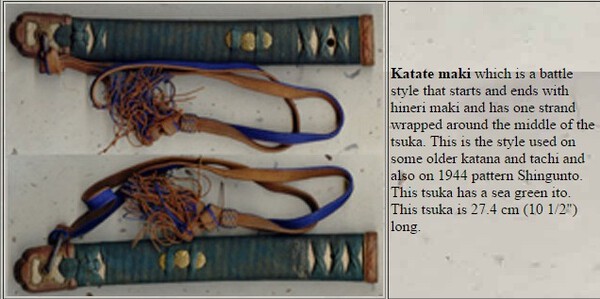-
Posts
1,690 -
Joined
-
Last visited
-
Days Won
11
Content Type
Profiles
Forums
Events
Store
Downloads
Gallery
Everything posted by Dave R
-
To my mind this is a fully legit' shin-gunto. Mismatched scabbard, the sword originally had a wood and leather scabbard. No surprises there. according to the maintenance teams that went out to China in WW2 the scabbard was the most often damaged part. Battlefield pickups often also have mismatched scabbards, being put together on the field in the aftermath of combat. I have also seen some very odd but original leather covers, leather being a wartime shortage item. Not the prettiest piece, but to me the family connection trumps cosmetic considerations.
-
Rare, but not unknown to have a leather covered saya with the metal mounts over all. Sometimes it's a light weight mount over wood, other times it looks to be over the standard metal saya.
-
-
Perhaps the pitting came first, and the horimono done to cut out and obscure the worst of it.
-
Wow!
-
I think it's a "bitser" or shot gun job. Vice marks on the habaki, army menuki, a badly done wrap, but for the most part original WW2 parts but from different swords .
-

Can You Help With Any Information On A Sword.
Dave R replied to blackandamber's topic in Military Swords of Japan
The fuchi looks ok to me. You can get a bit of variation in them, due to different manufacturers producing them. What is nice about it is that it is a cherry blossom pattern rather than the stipple pattern so often seen on the leather tab locking type. -

Mark On 15 Inch Sword - On The Back Of The Tsuba
Dave R replied to gary4554's topic in Military Swords of Japan
Tsuba or nakago? -

Interesting Gunto Mountings
Dave R replied to Ontario_Archaeology's topic in Military Swords of Japan
It was explained to me by a curator at the Royal Armouries that the Same is boiled until it's no more than collagen and nodes rather than skin. The hard nodes are then painstakingly applied to the saya, lacquered and then cut back to a smooth surface. I have no doubt I have simplified the process and skipped a step or twenty, but you can see why this finish is so rare. I once had a Wakizashi with this finish on the saya, let it go and regretted it since...... I did notice what looked like a seam on the ura of the saya I had, so I think the same is not applied directly, but to a substrate which is then glued to the wood of the saya. -
Actually the restrictions are easily circumvented. I suppose it's all a matter of personal experience.
-
Nowt much wrong with Ebay or Paypal, every market, every payment option has it's problems.
-
Have you asked him for photo's of what he says arrived?
-
Makes a lot of sense, copper plate to give a traditional appearance, but with a cheaper metal. Also improves corrosion resistance. I think most of the brass mounts on the 94 and 98 are copper plated as well, so little needed doing in the way of production changes.
-
For carbon dating there needs to be a decent amount of carbon to be tested! The carbon in steel doesn't count.
-
I would take that with a pinch of salt! Very high percentages of alcohol absorb water from the air, so it "might" be 100% (more likely 99%) when it leaves the factory but as soon as you open the container....... Which is why I transfer mine to smaller bottles for frequent use (on blades) to reduce dilution.
-
I think you will regret missing this... not today, but some time down the line!
-
Likely, indeed almost certainly a suraige blade, but still within regulation length, and a little long for "crew mounts". I have read elsewhere that Gunto no Soho put some emphasis of speed of draw, so my guess is it was shortened to facilitate that. It was in field mounts rather than formal ones after all. An online conversation about Gunto no Soho here. http://www.e-budo.com/archive/index.php/t-14638.html
-
Right click the picture, open the picture in Windows "Paint", click "resize" and then put the % number in the box for how much you want to enlarge it, click "ok", and "save" .
-

Newly Acquired Type 95 And Type 98(?)
Dave R replied to DavidCarroll's topic in Military Swords of Japan
And a "Sho" stamp! Non traditionally made in some aspect of manufacture/ -

Newly Acquired Type 95 And Type 98(?)
Dave R replied to DavidCarroll's topic in Military Swords of Japan
I have not seen the baking powder trick before either. For a mild abrasive I use scrunched up aluminium foil as a scrubber, but you have to make sure to remove fragments of foil afterwards. -
Pretend there is no signature, pretend there is no paper. Do you like the blade at the price........
-

Trying To Find More Info On A Type 98
Dave R replied to Geoff Bogie's topic in Military Swords of Japan
Copper habaki are pretty standard and traditional on Japanese blades. The lack of stamps doesn't really mean much, it's their presence that gives additional information, but the style of the signature does, to me, indicate wartime production. The tang does have a decent shape unlike many wartime made swords which can be a bit sawn off in looks. There is some file work, aka yasuri mei, so I would say there are distinct possibilities of a decent blade.... even if it proves to be non traditionally made. -

How And Why Of Modern Collecting
Dave R replied to Peter Bleed's topic in General Nihonto Related Discussion
I suppose I come under the heading of "treasure hunter" here, in that I buy at the lower end and then research what I have. There are those who disdain this approach, but for me the result is that I do actually have a collection, Nihonto and Showato (Gunto) blades and tosogu. If I had the income to do otherwise, then I might have gone in the other direction, but I wouldn't swear to it. The hunt is such fun. One proviso though, I buy my blades in hand at the antique and militaria fairs because there is such a risk buying from a photo' and even a "cheap" blade is a big chunk of my limited disposable income. I buy tosogu over the internet from Japan, because it is so much cheaper, a wider choice and the outlay represents a smaller proportion of available funds. All that said, previous research does really pay off, I have dodged a couple of bad deals due to keeping my eyes open. -
Ignore the string tag, the winged wheel is another matter. http://ohmura-study.net/308.html
-
Here we go again!..... Marco, do you have any other information to share on this blade? Nakago pics, is it a live auction (there are rules about comments on such) and if so who is selling it and the sellers information on it.



